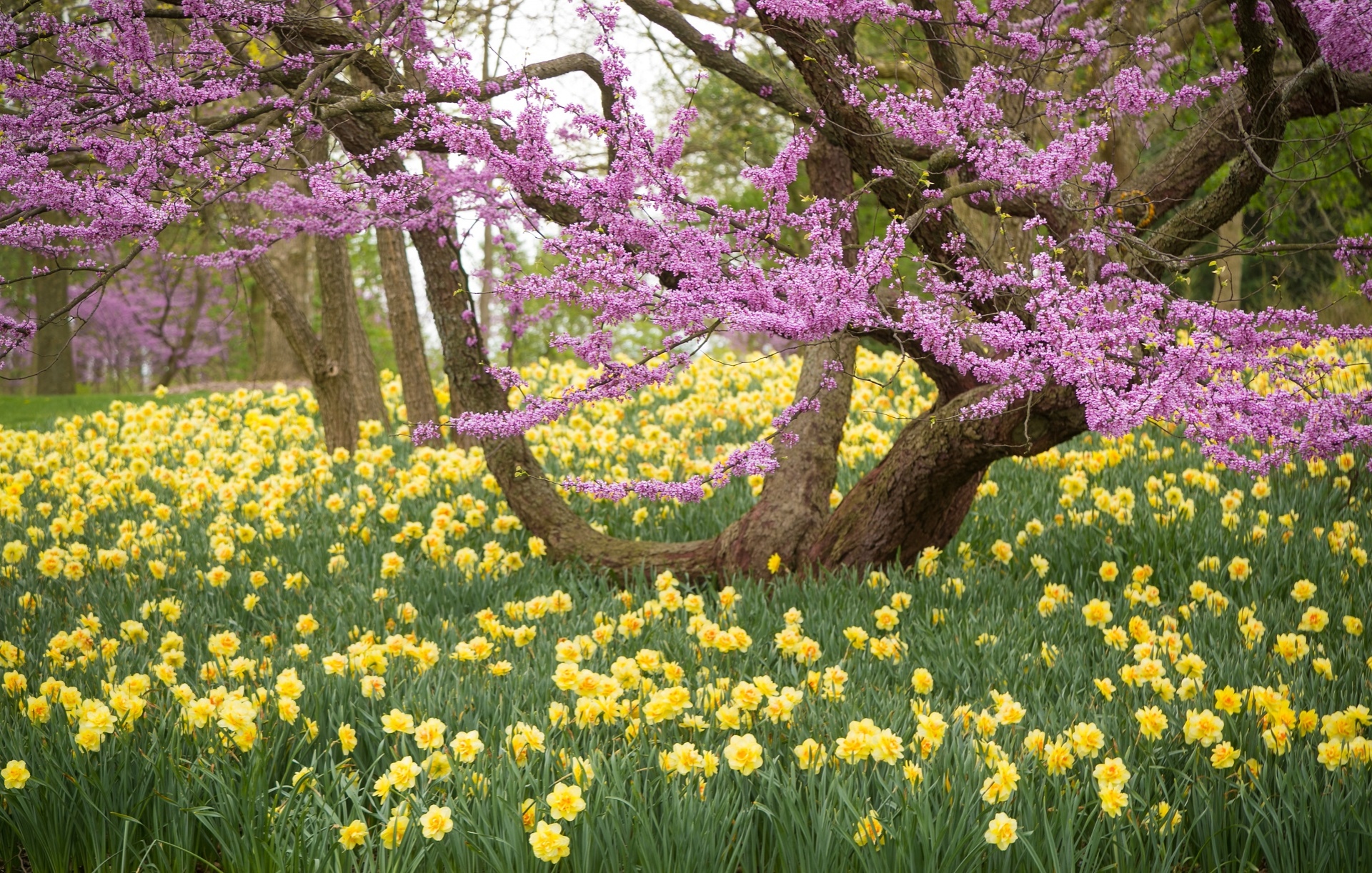April 28, 2023
The spring bloom season at The Morton Arboretum continues this week, with charming color to be seen among trees in bloom. Redbuds and crabapples are flowering, and dogwoods will be in full flower with a bit of warmth. There are still plenty of wildflowers to see, although the trees overhead are opening their leaves and beginning to cast the woods into shade. Sweeps of daffodils, bright gardens, and seasonal displays of bulbs and annual flowers provide color for everyone to enjoy.
There is plenty of color in the seasonal displays and container plantings around the Visitor Center, Arbor Court, and The Grand Garden (Parking Lot 1), as well as around the Thornhill Education Center (Parking Lot 21). Near Thornhill, find blooms in the Four Seasons Garden, the Fragrance Garden, and the perennial gardens along Joy Path.
Near the Visitor Center, look for orange-red blooms on flowering quinces; white blooms on pear and crabapple trees and viburnum shrubs; pink and lavender flowers on magnolia trees. Along the ground there are plenty of blue flowers among the periwinkles and Virginia bluebells. On the east side of Meadow Lake, pawpaw trees have dark maroon flowers and white dogwoods are beginning to bloom.
Near Parking Lot 2, find lavender flowers on redbuds and yellow-green blooms on buckeyes, above sweeps of late-blooming yellow daffodils. Catkins–tree flowers–dangle on ironwood, blue-beech, walnuts, and hickories. Carolina silverbell is starting to open its white blooms near Parking Lot 3, where late dark-lavender magnolias are also blooming.
Within a short walk from Parking Lot 4, it’s easy to find blooms on quince shrubs and pear and crabapple trees. The annual display of pink, white, and red crabapple blossoms has begun near Crabapple Lake (Parking Lot 5). Nearby are more daffodils and late-blooming magnolias. A walk along the trail from Parking Lot 6 will show you yellow- and red-flowering buckeyes. In the Oak Collection, near parking lots 7 and 8, oak trees are blooming.
Woodland wildflowers bloom along the forest floor, especially near Parking Lot 8 and Parking Lot 16. Among them are spring beauty, toothwort, white dog-toothed violets, bellwort, ironwood, Virginia bluebells, violets, wood anemone, false rue-anemone, celandine-poppy, buttercups, woodland phlox, wild geranium, and trillium. A few early May-apples are blooming. The blooms of spring ephemeral wildflowers will not last long, as the leaves of trees overhead are beginning to open and create the forest canopy of leaves.
Throughout the woods, sugar maples are blooming overhead, and many lavender redbuds can be seen in the understory.
At the Maple Collection (Parking Lot 14), tree flowers can be seen on maples and beeches, as well as more sweeps of daffodils. In the Eastern United States Collection (Parking Lot 16), you can see the blooms of redbuds, buckeyes, and dogwoods. You will also find the Arboretum’s largest patch of blooming pawpaws.
In the China Collection (Parking Lot 17) look for fragrant honeysuckle, pear trees, rhododendrons, and flowering dogwoods along the main road.
On the West Side of the Arboretum, pause at Parking Lot 19 to see flowering trees including pears, yellow magnolias, and crabapples. At the Thornhill Education Center (Parking Lot 21), browse the Four Seasons Garden, the Fragrance Garden, and perennial plantings along the upper part of Joy Path.
The West Side Alternate Route takes you through Sargent’s Glade (Parking Lot 26), where daffodils are in flower, to Lake Marmo (Parking Lot 28), with its redbuds, Virginia bluebells, and flowering dogwoods. The West Side Main Route takes you through Daffodil Glade (Parking Lot 22), with its mix of daffodils and wildflowers, to the Schulenberg Prairie (Parking Lot 25).
Birch and nut trees near Parking Lot 31 have catkins that dance in the wind as they hang along bare branches. End your bloom tour at Godshalk Meadow (Parking Lot 33), where you will see blooms on pear trees and lilacs, as well as early-blooming perennial flowers.
The stars of spring bloom change every week in the Arboretum’s gardens, collections, and natural areas. Each visit brings new characters to nature’s stage. Visit often to see all the color and drama!
Featured in this week's Spring Bloom Report






